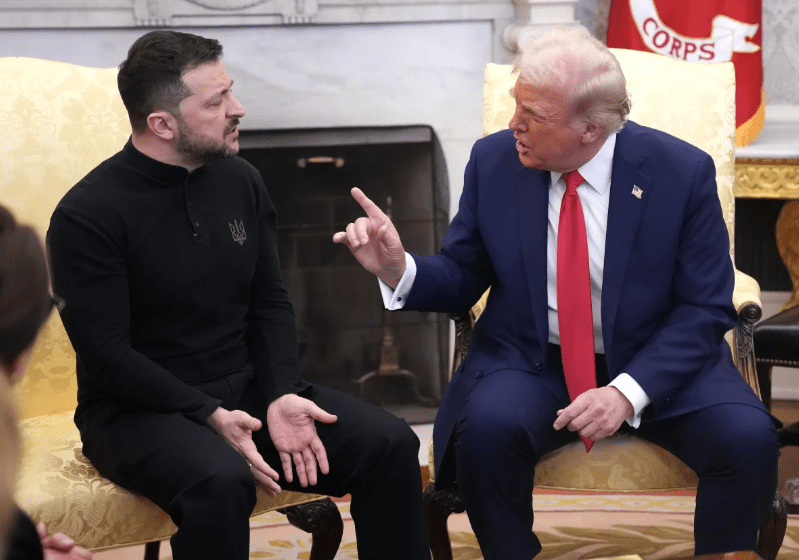The visit of Ukrainian president Volodymyr Zelensky to the White House has not gone to plan – at least not to his plan. There were extraordinary scenes as a press conference between Zelensky and Trump descended into acrimony, with the US president loudly berating his opposite number, who he accused of “gambling with world war three”.
“You either make a deal or we’re out,” Trump told Zelensky. His vice-president, J.D. Vance, also got in on the act, accusing the Ukrainian president of “litigating in front of the American media”, and saying his approach was “disrespectful”. At one point he asked Zelensky: “Have you said thank you even once?”
Reporters present described the atmosphere as heated with voices raised by both Trump and Vance. The New York Times said the scene was “one of the most dramatic moments ever to play out in public in the Oval Office and underscored the radical break between the United States and Ukraine since Mr Trump took office”.

Underlying the angry exchanges were differences between the Trump administration and the Ukrainian government over the so-called “minerals deal” that Zelensky was scheduled to sign. The deal looked more like a memorandum of understanding that leaves several vital issues to be resolved later. On offer is the creation of what will be called a “reconstruction investment fund”, to be jointly owned and managed by the US and Ukraine.
Into the proposed fund will go 50% of the revenue from the exploitation of “all relevant Ukrainian government-owned natural resource assets (whether owned directly or indirectly by the Ukrainian government)” and “other infrastructure relevant to natural resource assets (such as liquified natural gas terminals and port infrastructure)”.
This means that private infrastructure – much of it owned by Ukraine’s wealthy oligarchs – is likely to become part of the deal. This has the potential of further increasing friction between Zelensky and some very powerful Ukrainians.
Meanwhile, US contributions are less clearly defined. The preamble to the agreement makes it clear that Ukraine already owes the US. The very first paragraph notes that “the United States of America has provided significant financial and material support to Ukraine since Russia’s full-scale invasion of Ukraine in February 2022”.
Best video out of the Zelensky / Trump meeting was the reaction of Ukraine’s ambassador.pic.twitter.com/OGuFhY28S9
— Marina Medvin
(@MarinaMedvin) February 28, 2025
This figure, according to Trump, amounts to US$350 billion (£278 billion). The actual amount, according to the Ukraine Support Tracker of the Kiel Institute for the World Economy, is about half that.
Western and Ukrainian analysts have also pointed out that there may be fewer and less accessible mineral and rare earth deposits in Ukraine than are currently assumed. The working estimates have been based mostly on Soviet-era data.
Since the draft left details on ownership, governance and operations to be determined in a future fund agreement, further rounds of negotiations were felt to be inevitable.
Statement of intent
From a Ukrainian perspective, this should have been seen as more of a strength than a weakness. It leaves Kyiv with an opportunity to achieve more satisfactory terms in future rounds of negotiation. Even if any improvements will only be marginal, it keeps the US locked into a process that is, overall, beneficial for Ukraine.
Take the example of security guarantees. The draft agreement offers Ukraine nothing anywhere near Nato membership. But it notes that the US “supports Ukraine’s efforts to obtain security guarantees needed to establish lasting peace”, adding that: “Participants will seek to identify any necessary steps to protect mutual investments.”
The significance of this should not be overstated. At its bare minimum, it is an expression of intent by the US that falls short of security guarantees but still gives the US a stake in the survival of Ukraine as an independent state.
But it is an important signal both in terms of what it does and does not do – a signal to Russia, Europe and Ukraine.
Trump does not envisage that the US will give Ukraine security guarantees “beyond very much”. He seems to think that these guarantees can be provided by European troops (the Kremlin has already cast doubts on this idea).
But this didn’t mean the idea was completely off the table. On the contrary, because the US commitment is so vague, it gives Trump leverage in every direction — if he and Zelensky find a way forward, which is by no means certain.
He can use it as a carrot and a stick against Ukraine to get more favourable terms for US returns from the reconstruction investment fund. He can use it to push Europe towards more decisive action to ramp up defence spending by making any US protection for European peacekeepers contingent on more equitable burden-sharing in Nato.
But the row in the White House is also likely to have done yet more damage to the transatlantic relationship. Most European leaders have rallied behind Zelensky again, but there is now a very real chance that Trump will abandon both Europe and Ukraine when he cuts a deal with Putin.
And he can signal to the Russian president, Vladimir Putin, that the US is serious about making a deal stick – and that higher American economic stakes in Ukraine and corporate presence on the ground would mean US-backed consequences if the Kremlin reneges on a future peace agreement and restarts hostilities.
This argument has lost much of its credibility, though, after the shouting match between Trump and Zelensky.
That these calculations will ultimately lead to the “free, sovereign and secure Ukraine” that the agreement envisages is not a given.
For now, however, he very public argument between the parties about the shortcomings and vagueness of the deal on key issues — and the very public argument between the parties, and how to move forward — raise the question of whether Zelensky has gambled away more than just his country’s minerals.

